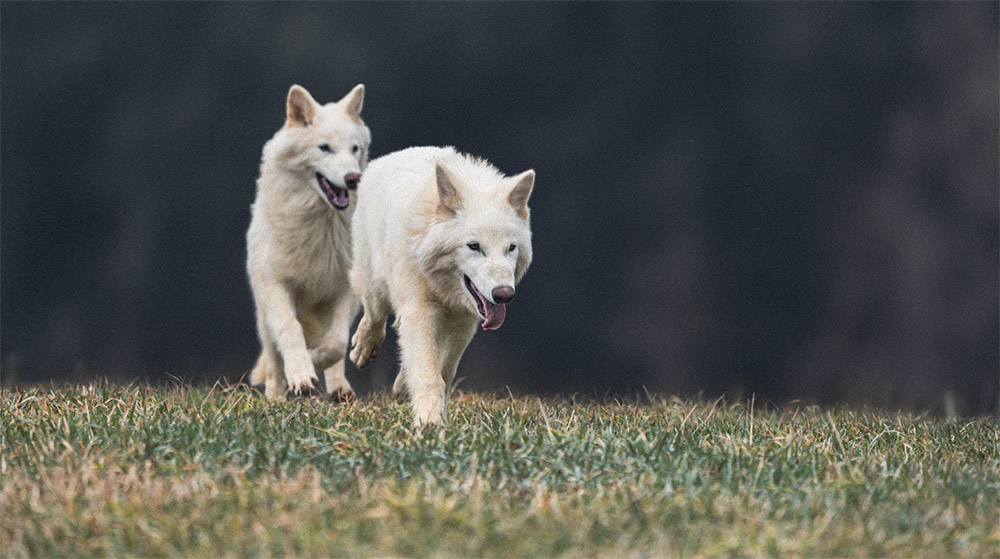In a Dallas laboratory, scientists have achieved what many thought impossible: successfully editing 20 genes in a single animal to bring back a species extinct for over 12,000 years. Colossal Biosciences’ dire wolf de-extinction represents the most complex genetic engineering feat ever accomplished in a vertebrate, setting new standards for precision genome editing while offering hope for conservation efforts worldwide.
Record-Breaking Genetic Engineering Achievement
The dire wolf breakthrough shatters previous records in genetic modification. While Colossal’s earlier “woolly mouse” project held the previous record with eight precision edits, the dire wolf required 20 unique genetic modifications across 14 different genes—a quantum leap in complexity that demonstrates the rapidly advancing capabilities of CRISPR technology.
“The dire wolf is an early example of this, including the largest number of precise genomic edits in a healthy vertebrate so far. A capability that is growing exponentially,” explained Dr. George Church, Harvard geneticist and Colossal co-founder.
These modifications weren’t random changes but carefully targeted alterations designed to resurrect specific dire wolf traits: larger body size, muscular builds, wider skulls, bone-crushing teeth, thick light-colored coats, and distinctive vocalizations. Scientists identified three gene variants for light coat color that had been completely absent in gray wolves for millennia, requiring sophisticated genetic archaeology to restore.
Revolutionary Non-Invasive Methodology
Colossal’s approach revolutionizes traditional cloning methods by eliminating the need for invasive tissue sampling. Instead of harvesting cells through surgical procedures, the team developed a breakthrough blood cloning technique using endothelial progenitor cells (EPCs) isolated from simple blood draws.
This innovation solved multiple challenges simultaneously. Scientists drew blood from living gray wolves and isolated EPCs—cells that line blood vessels—before applying CRISPR gene-editing to precisely rewrite DNA at 14 target genes. The process required extraordinary precision, including engineering solutions for potential complications where certain coat-color gene variants might cause deafness in wolves.
The edited nuclei were then transferred into 45 engineered embryos and implanted into carefully selected surrogate mothers. Remarkably, Colossal reported no miscarriages or stillbirths during the trials, indicating unprecedented success rates for such a complex de-extinction effort.
Ancient DNA Meets Cutting-Edge Science
The technological foundation begins with paleogenomics—extracting usable genetic material from fossils thousands of years old. Colossal’s team worked with a 13,000-year-old dire wolf tooth found in Ohio and a 72,000-year-old skull from Idaho, creating what experts call “a new standard for paleogenome reconstruction.”
Dr. Beth Shapiro, Colossal’s chief science officer and leading ancient DNA expert, celebrated the project as a breakthrough in computational genomics. The team didn’t just sequence fragments of ancient DNA—they reconstructed complete dire wolf genomes and compared them systematically with modern gray wolves, discovering that the species share 99.5% of their genetic code despite evolutionary divergence hundreds of thousands of years ago.
Immediate Conservation Applications Beyond De-Extinction
The dire wolf technology immediately translated into conservation wins for living species. Using identical methodologies, Colossal successfully birthed two litters of critically endangered red wolves—Hope, Blaze, Ash, and Cinder—representing four new individuals from three distinct genetic lineages.
This achievement provides a 25% increase in red wolf genetic diversity, crucial for a species that exists only because of a captive breeding program founded by just 14 individuals. The blood cloning platform allows conservationists to rapidly expand biobanking efforts for species on the brink of extinction.
“The same technologies that created the dire wolf can directly help save a variety of other endangered animals as well. This is an extraordinary technological leap for both science and conservation,” noted Dr. Christopher Mason, scientific advisor to Colossal.
Implications for Reversing the Extinction Crisis
Conservation leaders view Colossal’s achievement as potentially transformative for addressing what scientists call the sixth mass extinction. Robin Ganzert, CEO of American Humane Society, described the technology as possibly “the key to reversing the sixth mass extinction and making extinction events a thing of the past.”
The methodology creates new possibilities for genetic rescue programs targeting species suffering from genetic bottlenecks. Beyond dire wolves, Colossal has begun applying similar techniques to the pink pigeon project, introducing genetic diversity to combat severe population constraints that threaten species survival.
Mike Phillips, Director of the Turner Endangered Species Fund and veteran of gray wolf restoration in Yellowstone, emphasized the technology’s potential: “Perfecting genomic tools to integrate ‘ghost alleles’ from Gulf Coast canids would increase red wolf genetic diversity and generate knowledge for recovering other imperiled species, like the bolson tortoise, that are compromised by restricted ranges and reduced genetic diversity.”
Pathway to Ambitious Future Projects
The dire wolf success validates Colossal’s comprehensive de-extinction technology stack, boosting confidence for even more ambitious targets. The company aims to resurrect woolly mammoths by 2028, having already created 38 “woolly mice” as proof of concept. Plans are underway to attempt elephant pregnancies with mammoth-variant embryos by 2026.
Additional species in development include the Tasmanian tiger and the dodo, each presenting unique challenges that build upon lessons learned from the dire wolf achievement.
The technological implications extend far beyond individual species recovery. As Dr. George Church noted, the capability for complex multi-gene editing is “growing exponentially,” suggesting that today’s 20-edit record may soon seem modest compared to future achievements.
This scientific milestone represents more than technological prowess—it demonstrates humanity’s growing capacity to repair ecological damage and restore lost biodiversity through precision genetic engineering, potentially rewriting the rules of conservation for the 21st century.






